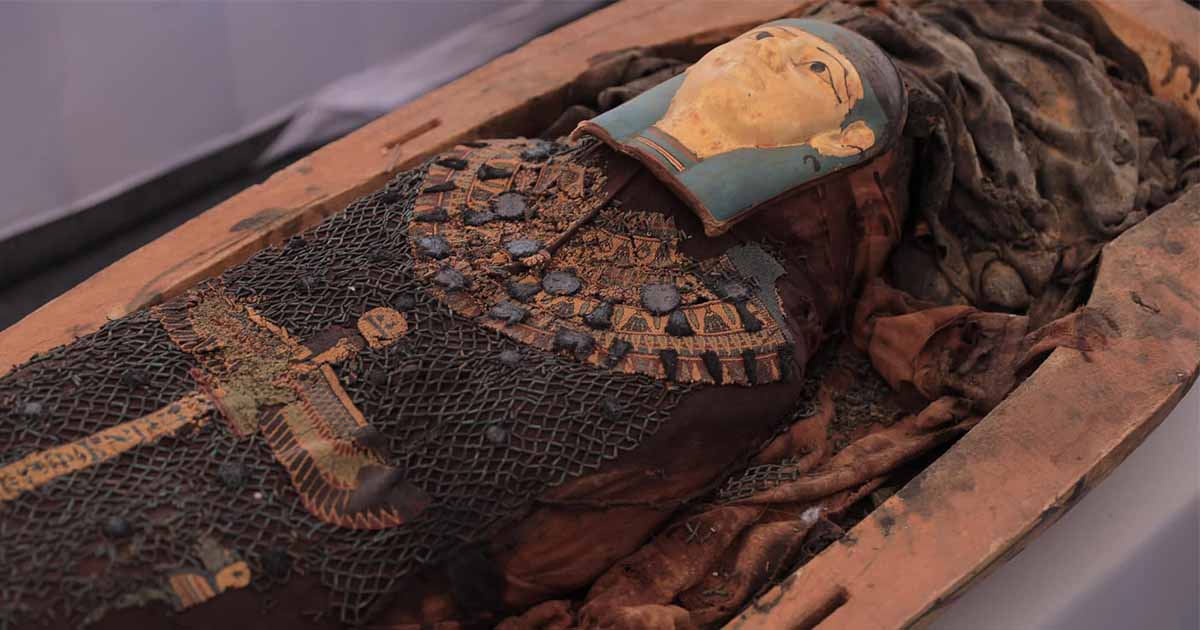High Officials and Priests Cemetery Yield Stunning Array of Artifacts in Egypt
Egypt‘s Ministry of Tourism and Antiquities reveals a remarkable cemetery from the New Kingdom. This unprecedented discovery includes a 13 to 15-meter (42.65 to 49.21 feet) long scroll illustrating The Book of the Dead, a first in the Griefa area.
The monumental archaeological discovery was revealed during a press briefing hosted by the Ministry of Tourism and Antiquities, at the renowned Griefa archaeological site, in Tuna Al-Jabal, Minya Governorate.
Professor Ghada Shalaby, Deputy Minister of Tourism and Antiquities, Dr. Mustafa Waziri, Secretary-General of the Supreme Council of Antiquities, and Dr. Mohamed Abu Zeid, Deputy Governor of Minya, announced the discovery of the cemetery, which was full of the tombs of high-ranking officials, powerful priests, and their treasures.
- A Day in the Life of an Ancient Egyptian Priest
- Book of the Dead: A Magical Guide to the Egyptian Underworld

Dr. Mustafa Waziri, revealing the wooden coffin, depicting "Ta Djesa," the daughter of a high priest of Jehuty in Ashmunein - "Irt-Heru. (Ministry of Antiquities)
Contextualizing the Cemetery
The discovery of this cemetery at Griefa, in Tuna Al-Jabal, adds a whole new dimension to the region's already rich archaeological landscape. In a recent Facebook press release Dr. Waziri said excavations began in the Griefa archaeological area in 2017, however, all previous archaeological findings in this area dated to the Old Kingdom [2686 BC-2181 BC] the First Intermediate Period [2181 BC-2055 BC] and the Middle Kingdom [2055 BC - 1650 BC], including the rock-cut tombs in the Sheikh Said and Deir Al-Barsha areas.
Describing the discovery as “a groundbreaking moment,” Dr. Mustafa Waziri described the most significant discoveries made by the mission up to now, including Late Period burial shafts leading to chambers with stone and wooden coffins, alongside “25,000+ Osirian figurines, canopic jars, shabtis, and stone/wooden statues.”
Now, the new discoveries include the bodies of regional rulers, esteemed high-ranking officials, and priests from the New Kingdom (1550 BC to 1070 BC), alongside an extensive list of grave goods.
- Necropolis Yields 1000s of Artifacts, Mummies and Ritually Buried Moon Priest
- New Necropolis Containing at Least Seventeen Mummies Unearthed in Egypt

Canopic jars found at the Griefa necropolis site. (Ministry of Antiquities)
Unfolding an Enormous Book of the Dead Scroll
Dr. Waziri described the cemetery as containing “numerous rock-cut tombs with hundreds of archaeological artifacts, stone and wooden coffins with mummies. Among the grave goods were amulets, jewelry, clay and wood pottery Osirian figurines, belonging to high-ranking officials, like for example, “Jehuty Mes, the overseer of the temple of Amun's bulls, and Nany, who held the title of Jehuty's singer.”
Perhaps the most significant discovery made at the cemetery was a well-preserved scroll, illustrating parts of The Book of the Dead, measuring 13 to 15 meters [42.65 to 49.21 feet] long. Representing, “the first complete papyrus ever found in the Griefa area,” this prized artifact will eventually be displayed in the Egyptian Museum.

Some of the beautiful shabti statues found. (Ministry of Antiquities)
Carved, Painted Coffins, and Canopic Jars
Helping to date the cemetery, the archaeologists identified a particular burial containing a carved and painted wooden coffin, depicting "Ta Djesa," the daughter of a high priest of Jehuty in Ashmunein - "Irt-Heru." Furthermore, two wooden boxes aligned beside Ta Djes’ body contained her canopic jars, used to safeguard specific organs like the liver, lungs, stomach, and intestines. As well as a complete collection of Osirian figurines, the researchers recovered a statue of “Ptah-Sokar,” a deity from ancient Egyptian religion, combining the attributes of “Ptah” and “Sokar”.
Since the Old Kingdom (2686 BC-2181 BC,) Ptah-Sokar was venerated throughout the expanse of ancient Egyptian history. Ptah, was associated with creation and craftsmanship, and Sokar, was an emblem of the afterlife and funerary rituals, and the syncretic nature of Ptah-Sokar's worship allowed for a seamless integration of the story from creation to the afterlife.
Top image: A carved and painted wooden coffin, depicting "Ta Djesa," the daughter of a high priest of Jehuty in Ashmunein uncovered at the Griefa cemetery Egypt. Source: Ministry of Antiquities
By Ashley Cowie

















